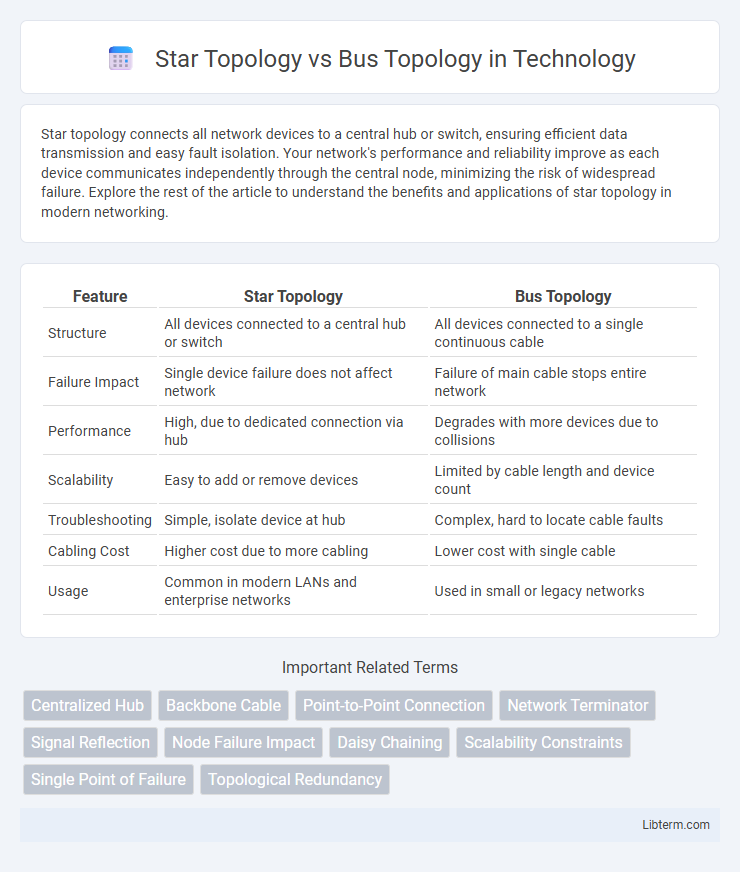Star topology connects all network devices to a central hub or switch, ensuring efficient data transmission and easy fault isolation. Your network's performance and reliability improve as each device communicates independently through the central node, minimizing the risk of widespread failure. Explore the rest of the article to understand the benefits and applications of star topology in modern networking.
Table of Comparison
| Feature | Star Topology | Bus Topology |
|---|---|---|
| Structure | All devices connected to a central hub or switch | All devices connected to a single continuous cable |
| Failure Impact | Single device failure does not affect network | Failure of main cable stops entire network |
| Performance | High, due to dedicated connection via hub | Degrades with more devices due to collisions |
| Scalability | Easy to add or remove devices | Limited by cable length and device count |
| Troubleshooting | Simple, isolate device at hub | Complex, hard to locate cable faults |
| Cabling Cost | Higher cost due to more cabling | Lower cost with single cable |
| Usage | Common in modern LANs and enterprise networks | Used in small or legacy networks |
Introduction to Network Topologies
Star topology features a central hub or switch that connects all devices, facilitating efficient data transmission and easy fault isolation. In contrast, bus topology uses a single shared communication line, where all devices are attached to a common backbone, making it simpler but more prone to collisions and network failures. Understanding these fundamental network topologies aids in designing scalable and reliable communication infrastructures.
What is Star Topology?
Star topology is a network configuration where each device connects to a central hub or switch, enabling efficient data transmission and simplified troubleshooting. The central node manages traffic, minimizing collision risks and enhancing overall network performance. This topology is favored for its scalability and reliability compared to bus topology, which relies on a single communication line.
What is Bus Topology?
Bus topology is a network configuration where all devices are connected to a single central cable, known as the bus or backbone. Data transmitted from a device travels along the bus in both directions until it reaches the intended recipient, making it a cost-effective solution for small networks. However, bus topology faces limitations such as signal degradation over long distances and difficulty isolating faults, which can disrupt the entire network.
Key Differences Between Star and Bus Topologies
Star topology features a central hub or switch connecting each device individually, enhancing fault isolation and simplifying network troubleshooting, while bus topology uses a single shared communication line to connect all devices, making it more prone to network failure if the main cable is damaged. Data transmission in star topology is more efficient since signals travel directly through the central hub, whereas bus topology relies on a linear backbone that can cause data collisions and degrade performance under heavy traffic. Scalability in star topology is superior, allowing easy addition or removal of devices without disrupting the network, unlike bus topology where modifying the network can be more complex and may require segmenting the bus.
Advantages of Star Topology
Star topology offers enhanced network reliability since each device connects independently to a central hub, reducing the risk of network failure from a single cable fault. It provides superior performance with dedicated point-to-point connections that minimize data collisions and improve communication speed. Troubleshooting and maintenance are simplified due to centralized management, allowing quick identification and isolation of network issues.
Advantages of Bus Topology
Bus topology offers simplicity and cost-effectiveness by requiring less cabling compared to star topology, making it ideal for small networks. It allows easy expansion by adding devices to the main cable without complex configurations. The linear layout of bus topology minimizes network installation time and reduces the need for additional hardware like switches or hubs.
Disadvantages of Star Topology
Star topology disadvantages include a single point of failure at the central hub, which can disrupt the entire network if the hub malfunctions. It typically requires more cabling than bus topology, increasing installation costs and complexity. Scalability can be limited by the hub's capacity, making it less efficient for very large networks.
Disadvantages of Bus Topology
Bus topology suffers from limited cable length and the number of nodes, which restricts network size and scalability. Fault isolation is difficult because a single cable failure can disrupt the entire network, leading to decreased reliability. Performance degrades with increased traffic due to data collision risks and shared bandwidth constraints.
Use Cases: When to Choose Star or Bus Topology
Star topology is ideal for networks requiring high reliability and easy fault isolation, such as corporate offices where devices connect to a central switch for efficient data management. Bus topology suits small, temporary, or linear network setups like small workgroups or testing environments due to its simplicity and cost-effectiveness. Choosing star topology enhances scalability and performance in growing networks, while bus topology supports quick deployment with fewer cables in environments prioritizing minimal setup.
Conclusion: Star vs Bus Topology
Star topology provides superior fault tolerance and easier scalability compared to bus topology, as each device connects independently to a central hub, minimizing network disruption when a single cable fails. Bus topology is simpler and more cost-effective for small networks but suffers from increased collision risks and reduced performance with more devices. Therefore, star topology is preferred for larger, high-performance networks, while bus topology suits smaller, less complex setups.
Star Topology Infographic

 libterm.com
libterm.com